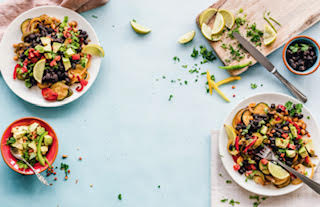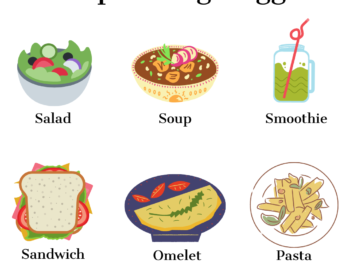One of the best ways to practice healthy eating is to surround yourself with a variety of nutritious foods. Having spent a good part of my career helping clients get healthier, one of the first things we discuss is how to go food shopping (or order online) the healthy way. As I write in my book Finally Full, Finally Slim, what you bring into your house you will eat. If you buy healthy foods and ingredients, you will cook with them and eat them. If you bring junk food into the house, guess what? That’s what you’ll eat.
Making smart choices in the grocery store really is the key to good nutrition, at least when eating at home. While some people love grocery shopping (I do and love seeing the new products!), others see it as an onerous chore. Picking up a few simple shopping tips, however, can make your trip to the market much healthier.
1. Shop from a list.
Before heading out to the supermarket, plan ahead, and take stock of what ingredients you need to prepare healthy meals and snacks for the week. You can keep a paper shopping list or keep a running list on your phone so you know you won’t forget it. You can also download your favorite smartphone app. I still love old fashioned paper lists but since I often leave home without it, I snap a picture of my list and have it on my phone.
2. Don’t shop when hungry.
When you shop on an empty stomach, you tend to fill up on impulse purchases which are generally unhealthy. Eat a light meal or snack before heading to the market and you are more likely to skip to junk and shop from your list. This really does make all the difference.
3. Enlist your family.
To be sure your family will want to eat what you serve, get them involved in the preparation, and ask them if there’s anything special they want around the house; keep it healthy, of course. This will help them feel like they are part of a team.
This is where you are likely to find healthy foods such as produce. Start by filling your cart with colorful fresh fruits and vegetables. This will set you up for healthy shopping habits for the remainder of your trip. Avoid the center aisles where the junk foods lurk; skip that section entirely or save it for last.
5. Choose the rainbow.
The different colors of the rainbow reflect the different vitamins, minerals, and phytonutrients found in fruits and vegetables. Red produce, including tomatoes, watermelon, and pink grapefruits, tend to be rich in the antioxidant lycopene while orange produce, including carrots and cantaloupe, tend to be high in the antioxidant beta carotene. Go for color, including white (think cauliflower, onions)
Considering organic produce? Check out the Environmental Working Group for a list of the “dirty dozen” and “clean 15. The dirty dozen, including strawberries, spinach, and apples, are the produce with highest levels of pesticides so you may want to purchase these in organic varieties.
In addition to healthy produce, fill your cart with healthy foods from the various food groups: whole grains, low-fat dairy, fish, poultry, beans, legumes, nuts, and lean meats, and healthy oils such as extra virgin olive oil.
7. Choose packaged foods with a short ingredient list.
Choose minimally processed foods without lots of added sugar and salt. Choose foods that contain five ingredients or less and skip foods containing artificial ingredients, additives, and ingredients you can hardly pronounce. Frozen fruits and vegetables with nothing added are also great options to add to your shopping cart if you live alone and are worried your produce may go bad.
8. Don’t be fooled.
Read packaged food labels including the product’s ingredient list. Ingredients are listed in descending order of predominance by weight so the ingredient that weighs the most is listed first. Review the serving size and the calories per serving. And check the sugar and sodium content.
By 2020, you will be able to clearly see the calories and serving-size information along with a product’s “added sugars” on the package label.
Many package labels are using the new labels but while looking at labels that are still using the current label, read the ingredient list and look for the added sugars (look for terms including sucrose, high fructose corn syrup, sugar, honey, corn syrup). And coconut sugar, honey, and molasses are not health food either.
9. Steer clear of the health halos.
Don’t be fooled by certain terms which give off the impression that a food is healthier than it really is: multigrain, fat-free, organic, and gluten-free. Gluten-free cookies are still cookies.
10. Don’t buy in bulk.
Stocking up on paper towels can be a good idea (if you have the storage space) and save you money, but buying food in oversize packages will probably cost you lots of calories. We tend to eat more food from large packages and we usually do not even realize it so I don’t suggest stocking up on jumbo packages of nuts, cereal, chips, and crackers. Try purchasing snack foods in single servings; it will help you eat less. If you must buy in bulk, stock up on small baggies too—and divide and conquer!
11. Try a new food.
Be adventurous; aim to try a new fruit or vegetable each week. There are also so many yummy whole grains besides the usual whole wheat breads and cereals. Try Ezekiel bread, amaranth, spelt, quinoa, and Bulgar. Try soba noodles or chick pea pasta instead of whole wheat pasta for a change. Variety really is the spice of life.
12. Yes, make room for a treat.
I am not a fan of deprivation, so I do think it’s ok to buy and enjoy an occasional treat. If you are buying a treat food for the family, follow the rule of ONE: bring one fun food into the house at a time. Want to splurge on ice cream? Stick to just one flavor. The more flavors you have around the house, the more you will end up eating. Stick to a portion-controlled amount and choose a splurge you love. And, there are certain foods you may not want to even bring into the house if you know you will be tempted to overeat.
Enjoy!





 My opinion piece on celery juice (!) published on NBC news: “Miracle in glass? Not so fast…”
My opinion piece on celery juice (!) published on NBC news: “Miracle in glass? Not so fast…”